Configure Wanscam PTZ, Indoor, Outdoor Camera for Cloud Recording, Monitoring and Playback
Contents
Step 1: Connect camera to the network and find IP address
1.1 Connect camera to the network
1.2 Find the Camera’s IP Address
Step 2: Configure the Camera Using the Web-based Configuration Tool
2.1 Setup or Re-configure Wi-Fi
Step 3. Configure the FTP settings
Step 4. Configure Video Profile and Image/Video Recording Options
4.1 Configure Video / Image Settings (Resolution, Frame Rate, Bit Rate)
4.2 Configure Video or Image Recording
4.3 Configure Motion Detection
Introduction
Wanscam network cameras are usually compatible with CameraFTP cloud recording service. Please note Wanscam is different from Wansview. In general, we believe Wansview is better suited for cloud recording than Wanscam.
The camera model JW0004 that we tested is a little old and can only support 640x480 image recording. Newer models might have added H.264 video recording feature.
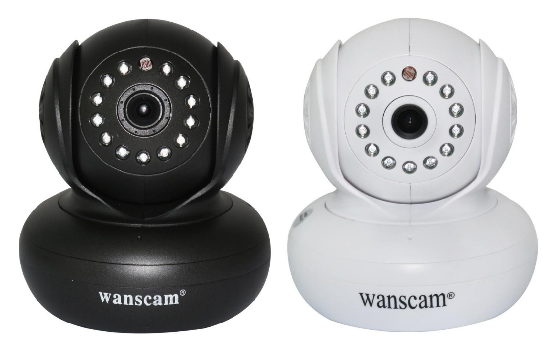
Its main features include:
- Supports 640x480 video resolution with up to 30 fps.
- Two-way audio, Remote Pan/ Tilt rotate, indoor use
- Extreme reliable WiFi connection. Support IEEE802.11b/g/n 150Mbps
- Supports both wired and wireless connection, but not PoE
- Easy WiFi Configuration via a network cable and web browser
- Motion detection with cloud image recording to FTP server
- Continuous image recording to FTP server at a max frequency of 1 image/s
- Does not support H.264 video/audio recording by itself, but can be supported via CameraFTP VSS.
- IR LEDs for Night Vision Up to 30 feet distance for 24-hour surveillance
Basic camera information
| Video / image resolution | 640x480, 320x240 |
| Audio recording | No. (Supported via CameraFTP VSS) |
| Image upload frequency | 1 image/s or lower frequency |
| Video frame rate | 1,2,3,...,25 fps |
| Night-vision | Up to 30 feet |
| Image snapshot recording | Supported |
| Video clip recording | Not supported. (Supported via CameraFTP VSS) |
| Motion detection | Supported |
| Continuous recording | Supported image recording |
| Supported video format | N/A |
| Connection type | Wi-Fi and Ethernet cable |
| PoE (Power on Ethernet) | No |
| Indoor / outdoor | Indoor |
| Lowest pricing (as of 7/1/2016) | New models available |
Note: This document is not designed to replace the product manual from the manufacturer. The information provided is based on our knowledge of the models Wanscam JW0004 Cameras. It may not be accurate or completely up-to-date. Users shall contact the manufacturer for all camera-related issues and contact us only for CameraFTP-related (cloud service / FTP) issues.
Most of the setup steps below are camera related and are very trivial. If you have finished these basic steps before, then you can skip Steps 1 and 2.
Step 1: Connect camera to the network and find IP address
1.1 Connect camera to the network
If you want to use wired connection, you just need to connect the Ethernet cable. Otherwise, there are several ways to connect the IP camera to your Wi-Fi network. Please read the product manual for detailed instructions.
(1) You can connect the camera with the router using an Ethernet cable first. You can configure the Wi-Fi settings in the camera's configuration pages later.
1.2 Find the Camera’s IP Address
Please refer to the manufacturer’s manual for more detailed information. Usually you will run the included IP Camera Search Tool to find the camera. If your computer does not have a DVD/CD drive, then you can download CameraFTP VSS software to find the camera's IP address. ( After you find the camera's IP address, you can stop / uninstall VSS. Note: This camera is compatible with VSS-based Cloud Recording. You can use VSS as a cloud-enabled NVR, which requires a PC. )

For CameraFTP VSS to locate this camera, you must manually enter the port number 99. New model cameras probably have supported ONVIF.
Step 2: Configure the Camera Using the Web-based Configuration Tool
Most IP cameras don't support Chrome, incl. this camera. So please download Firefox web browser if you don't have it already. Launch Firefox, and visit:
http://IP_ADDRESS:99/(e.g. http://192.168.1.2)

The default username is admin, and password is admin. (It is recommended that you change the password.)
After you log on to the camera, please install the Plug-in:
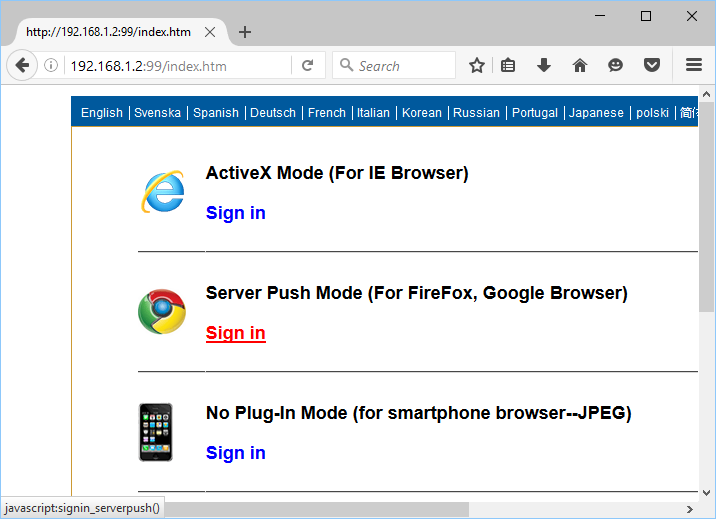
Click "Sign in", it will display the live view screen:
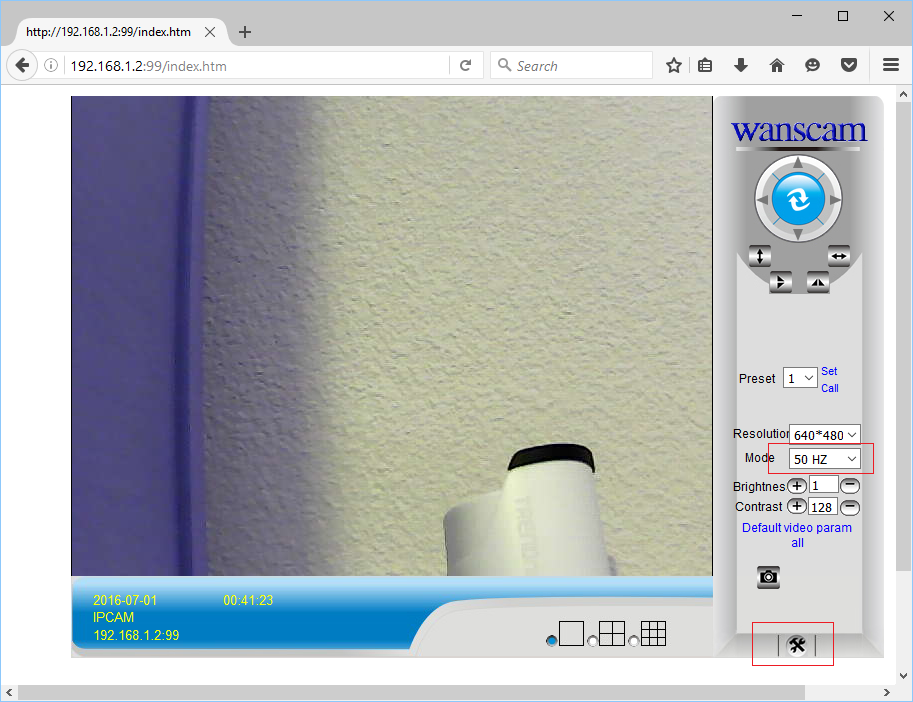
Click Setup, you will see the Setup Main screen.
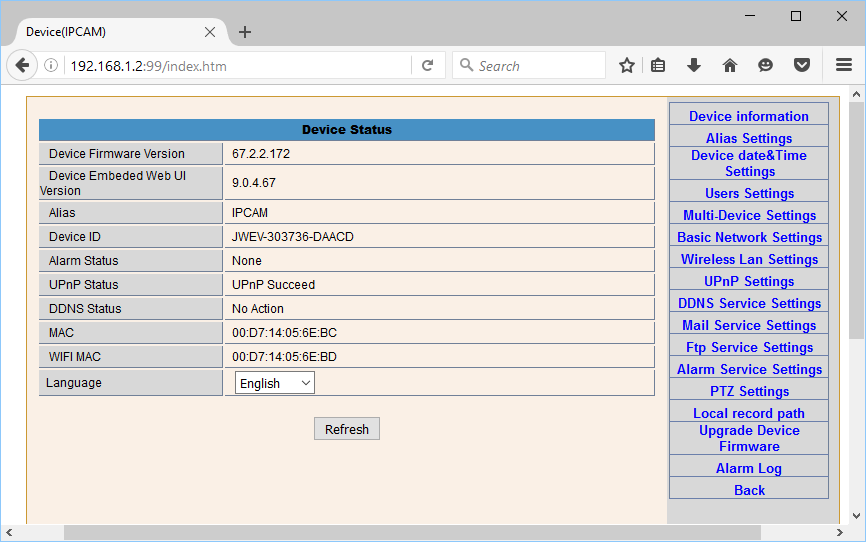
With CameraFTP's service, most regular setup steps are not required. (You can check these steps in the Camera Configuration screen to make sure everything is configured correctly).
2.1 Setup or Re-configure Wi-Fi
If you had already connected the camera with your wireless router, then skip this step.
Otherwise, click "Wireless Lan Settings", you will see the screen below.
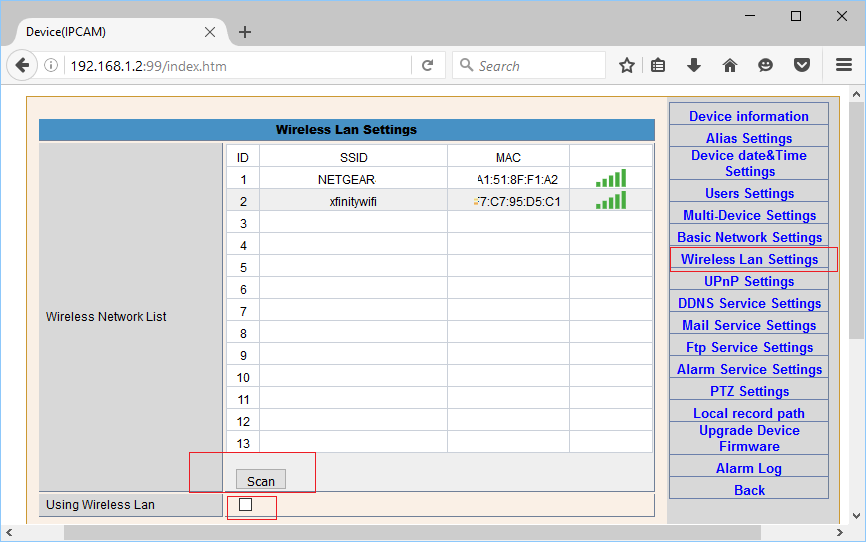
Click Scan to find all available Wi-Fi routers, then select a router to connect. You will be asked to enter the wireless password, after done, click Save.
If Wi-Fi is configured successfully, you can unplug your network cable later.
Step 3. Configure the FTP settings
Click FTP Service Settings, you can enter the FTP information as shown in the screenshot below.
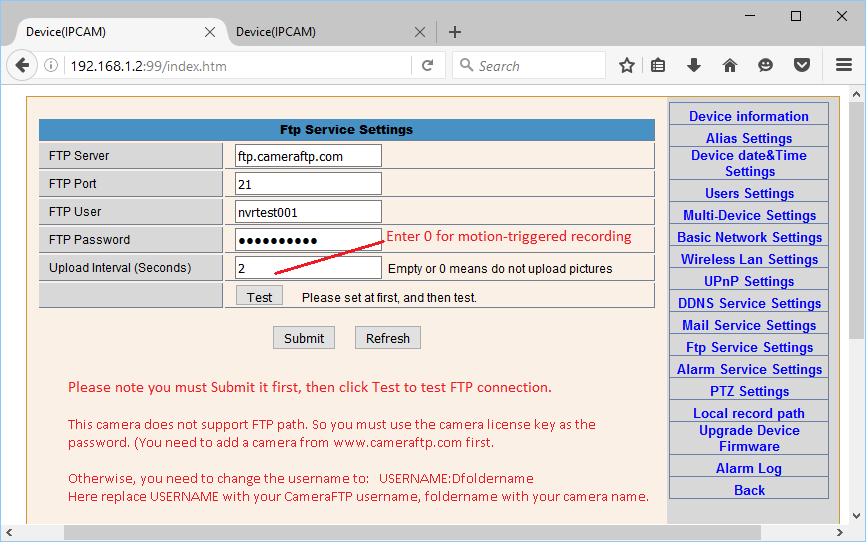
If you don't already have an account on CameraFTP, please visit www.cameraftp.com and sign up a free trial account. CameraFTP offers 3-day free trial. When the trial ends, you will need to order a subscription to continue using the service.
Assuming you already have a CameraFTP Account, then you need to enter the following info:
- FTP Server: ftp.cameraftp.com
- Port: 21
- FTP Mode: PASV (This camera uses PASV by default. No configuration is needed)
- FTP Path: This camera does not support FTP Path. So FTP path info must be provided in the username or license key.
- Username and Password: You can use the camera license key as the password; otherwise, you need to change the username to: USERNAME:Dfoldername
Note: If you use the camera license key as the password, you must add a camera from www.cameraftp.com first, then assign a license key to the newly created camera. Otherwise, you can use USERNAME:Dfoldername as the username. "foldername" is the same as the camera name that you created on www.CameraFTP.com website when you added a new camera.
Click Submit to save the settings. After that, you need to configure the video / image resolution.
Step 4. Configure Image Recording Options
If you ordered a motion triggered image recording plan, then you should configure Alarm Service Settings to upload images to FTP server. You need to check Motion Detect Armed, set motion sensitivity and Alarm Arming Time (set the schedule, usually "Select all". You also need to select an alarm interval.
The upload interval should be set based on your susbcription level. This camera can upload at 1 image/s or lower frequency.
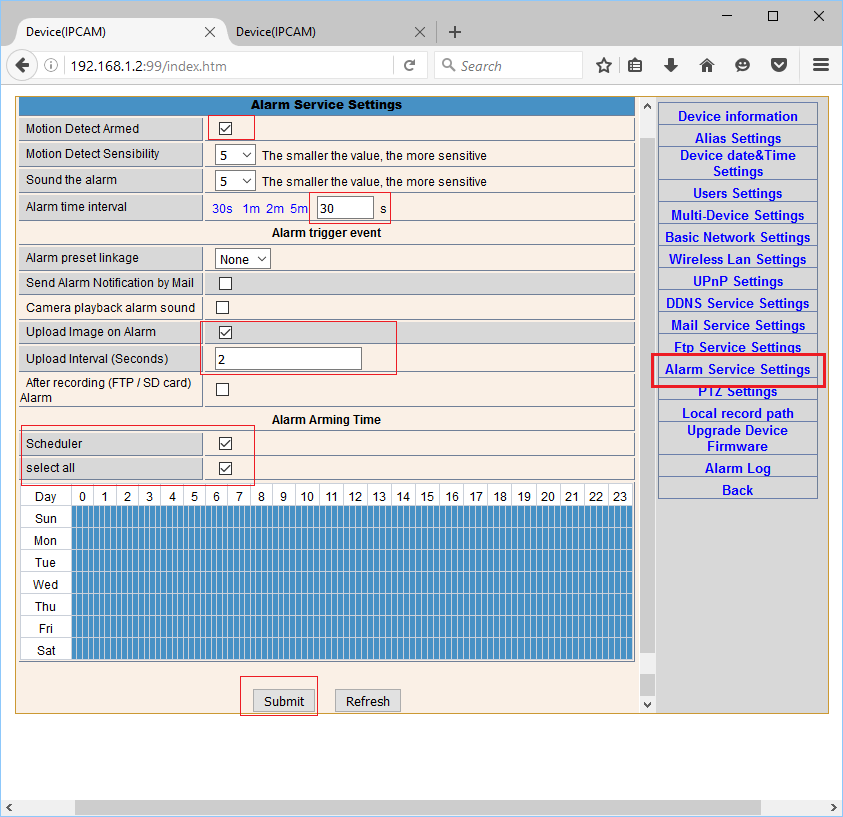
For continuous image recording, you can set an upload interval in the FTP Settings screen based on your susbcription level. Please don't set both continuous and motion triggered recording options.
Click Save to save the change.
NOTE: Please do not configure both video recording and image recording. It will be considered as two camera licenses!
You are all done!
5. CameraFTP Viewer
You can disconnect the Ethernet cable if you want to use Wi-Fi. If you need to make changes, you can run the CameraFTP Virtual Security System program again to find the camera’s IP address (as it may change with DHCP), and then access the camera’s Configuration pages.
After your camera is setup, you can visit www.cameraftp.com to view or play back your recorded footage from anywhere. You can also download CameraFTP Viewer App for iOS, Android and Windows Phone.
Note: This camera is compatible with VSS-based Live View, Cloud Recording and Local Recording. You can use VSS as a cloud-enabled NVR, which requires a PC. If you want to use VSS with this camera, you will need to select the following video stream:
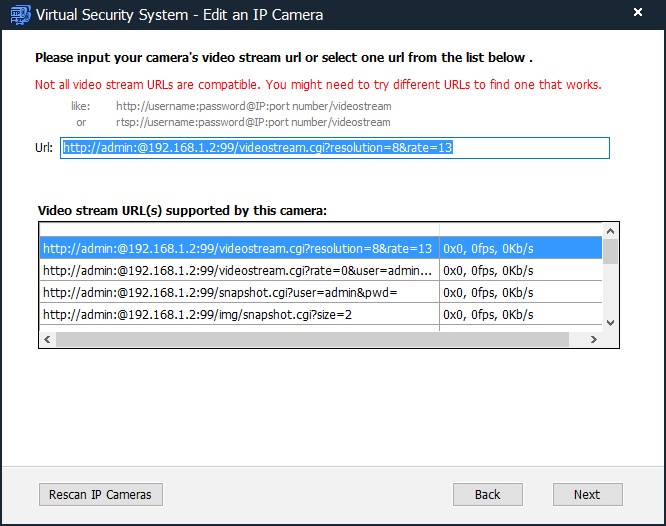
Cannot get it to work? Please read our Trouble-shooting Guide.
